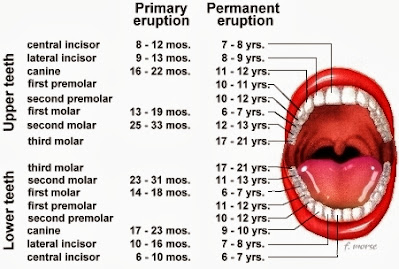Tooth Eruption Dates In Children
Background: It's important to note that eruption times vary form child to child just as the individual growth rates between children vary.
Normally, no teeth are visible in the mouth at birth. Occasionally, some babies are born with an erupted incisor (neonatal tooth), but these are not true teeth and are lost soon after birth. The first baby teeth to erupt are usually the lower two front incisors (mandibular central incisors) at about 6 months of age. They are followed by the 4 upper front teeth. The remainder of your child's teeth will appear periodically, usually in pairs on each side of the jaw, until all 20 baby teeth have come in at about 2 1/2 years of age. The last teeth to emerge are the top two molars (maxillary second molars at 30 months). The complete set of baby teeth are in the mouth from 2 years to 5 3/4 or 6 years of age (when no permanent teeth are present). Shortly after your child's 4th birthday, their jaw and facial bones will begin to grow creating spaces between their teeth. This is frequently a concern to parents, but it’s a perfectly natural process of providing the necessary space for the larger permanent teeth to emerge.
Though baby teeth are only in the mouth for a short time, they play a vital role in reserving space for their permanent counterparts. The primary teeth are crucial to your child's normal facial appearance and the formulation of clear speech. Missing or decayed baby teeth often cause children to reject foods that are difficult to chew. Decay and infection in baby teeth can cause dark spots on the permanent tooth developing beneath it.
The following diagram shows approximately when each baby tooth should erupt. Many variations occur, but the usual order of appearance is as follows:
- Teeth tend to erupt in pairs
- Lower teeth usually erupt before the upper teeth
- Girls generally preceded boys in tooth eruption
- The teeth in both jaws usually erupt in pairs - one on the right and one on the left.
- By the time the child reaches the age of two to three years, all the deciduous (baby) teeth should have erupted.
Tooth Eruption in Children
Permanent Teeth:
At about 6 years of age, the first permanent molars (upper and lower) and lower permanent incisors begin to erupt. Between the age of approximately 6 and 12 years, children have a mixture of permanent and deciduous teeth. This is known as the mixed dentition stage. By the age of 12 most children have all their permanent teeth, except for their wisdom teeth.
Eruption Dates for Permanent Teeth:
Development of Baby Teeth
Calcification begins during the fourth month of fetal life. By the end of the sixth month, all of the deciduous teeth have begun to calcify.
By the time the deciduous teeth have fully erupted (2 to 2 1/2 years of age), calcification of the permanent crowns has begun.
A Little on the Importance of Baby Teeth...
As a rule, baby teeth that become decayed should be restored and preserved until their normal time of exfoliation.
Though the issue of cost is relevant (baby teeth are temporary), they’re all your child has to chew with, speak with, and smile with for a number of years. They play an important role in their social development.
The deciduous second molars are particularly important. It is imperative that the deciduous second molars be preserved until their normal time of exfoliation. This prevents the mesial migration of the first permanent molars.
